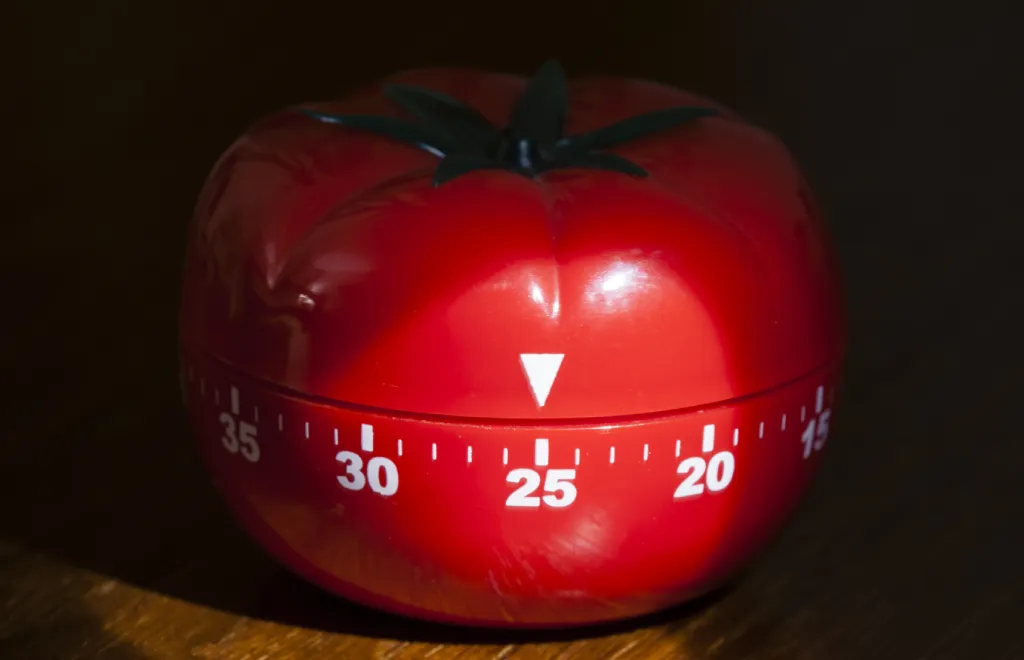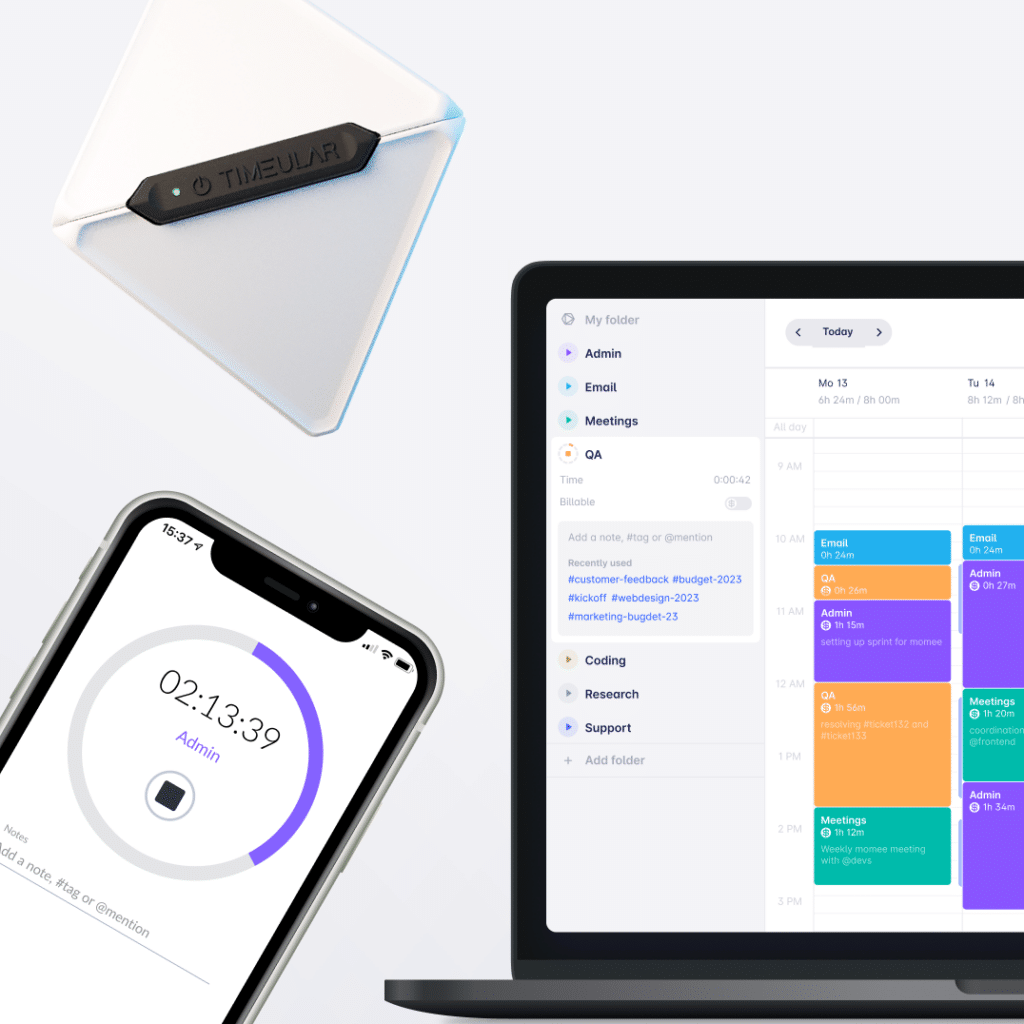Pomodoro Technique: What is It and How it Works
Most of us are inherent procrastinators and we need a reason to act now, whether it’s about splitting a project into tasks and awarding time for each task, or simply making a business decision. That is why we often find ourselves postponing difficult projects and pushing deadlines.
While some time management tips and methods are a dime a dozen, there are effective techniques that can supercharge your productivity, and help you beat procrastination.
One of these, which is highly acclaimed among productivity aficionados, is the Pomodoro technique, interestingly deriving from the italian word for tomato.
Looking for the best time tracking tool to use the Pomodoro technique on?
Thousands of businesses and individuals track their time with Timeular!
In this article you’ll find out what the Pomodoro technique is, how and why it works, as well as how to implement it into your daily routine to boost productivity.
And if you haven’t heard of the word “Pomodoro” in the business world, but only in the kitchen, as an italian word, you might be confused, we get it.
So, what is the Pomodoro technique?
The Pomodoro technique is a time management method developed by Francesco Cirillo, in the late 1980s. It gained popularity fairly quick, as it could be used on the run and implemented on the fly by everyone.
Having its origin in the Italian word for tomato, the Pomodoro technique is based on deep work bursts of 25 minutes followed by a five-minute break.
While at the beginning it was used only as tomato-shaped kitchen timer to organize the study schedule of the university student Francesco Cirillo, which is still used nowadays, the method has been later on integrated in time tracking apps, and even standalone applications created only based on the technique.
In essence, the Pomodoro technique is simple, yet effective due to it’s work-break pattern, which helps improve focus and with better concentration, while it fights cognitive boredom and enhances productivity.
Get to know the best ways to beat procrastination in our article.
How does the Pomodoro technique work?
The core process of the Pomodoro technique basically consists of:
- Picking one project or task you want to focus on
- Get a list of to dos and a timer
- Set your Pomodoro timer for 25 minutes and focus on a single task until the timer rings
- When your session ends, mark off one Pomodoro and record what you completed
- Then enjoy a well deserved pause, made of five minutes
- After four Pomodoros, take a longer break, like 15-30 minutes
The 25-minute Pomodoro time management method is a long enough session to stay focused, but not so long that you become easily distracted, while it’s easy to integrate it in the weekly routine.
Unlike trying to work without pausing for hours, it’s relatively easy to stack small sessions on top of each other with a structured method and less effort.
Four Pomodoro sessions can represent a super productive morning, making up your work intervals until lunch, or before your longer breaks. It’s surprising how much you can accomplish in short bursts of focused work.
Using the online Pomodoro timer is the most seamless way to implement the Pomodoro technique in your daily workflow.
Feeling overwhelmed? Discover how to get organized at work when overwhelmed with our guide.
Why is a Pomodoro 25 minutes?
When assessing closely, our attention spans have decreased over the last couple of years due to constant distractions. According to the researcher Jonathan Schooler, the average mind wanders for about 15-20% of the time.
While this percentage sounds worrying, a study concludes that short breaks are beneficial in keeping the attention span on track.
The psychology teacher leading the study mentioned that when faced with a large task, it’s best to impose a short break, as a brief mental pause actually helps in staying focused better.
So, when you use the Pomodoro, you’re able to focus on one task only for 25 minutes, followed by regular breaks, which helps you maintain focus throughout the day.

At the same time, you’re able to create an effective relationship between work and pauses, that doesn’t allow your mind to wander as much as it would when batching a one-hour task.
Concluding, twenty-five minutes is a short enough period for most people to feel encouraged to work on a task, while it can be integrated perfectly into daily work.
Check out the best tips to save time, we’ve included the Pomodoro technique, too.
Why does the Pomodoro technique work?
If you’re still in doubt about whether this technique works or not, here are some of the reasons we believe it does:
- Knowing that you only have 25 minutes to work on a big project before taking a break installs a sense of urgency
- You’re more likely to focus completely in those 25 minutes because you know they’re followed by 5 minutes during which you can relax before your next session
- It will force you to add more structure to your workday, making everything easier and smoother, while
- Getting started on a big task can sometimes take some effort and feel daunting, which is why many people procrastinate. Deciding that you’ll work on it for only 25 minutes before having a shot pause makes it a lot easier and less scary.
Did you know that multitasking decreases productivity because it can easily lead to distraction and fatigue?

Who can benefit most from the Pomodoro technique?
The Pomodoro technique can do great wonders if you struggle with procrastination and have a hard time focusing on your tasks for a long period of time.
Basically, we can say that Pomodoro is useful for everyone, whether you’re a: project manager, freelance writer, developer, web designer, team leader, and even in your personal life, when writing on your site a blog post.
How to follow the Pomodoro technique?
Here are a few tips for using the Pomodoro technique:

1. Get a Timer
First and foremost, you’ll need a Pomodoro app or Pomodoro timer for the technique to work.
You’ll then need to select multiple tasks for the day, order them and set your timer to 25 minutes for the first task. Then, work till the timer alerts you. After that, enjoy your pause! Even if you have gotten into a state of flow, it’s time to get up and enjoy five minutes off.
Remember, working continuously without taking short breaks can lead to stress, poor concentration, fatigue, and burnout.

Use Timeular as your Pomodoro timer!
Thousands of businesses and individuals track their time with Timeular!
2. Plan
Before you start working, take some time to plan your sessions or how many Pomodoros you need to complete multiple tasks. Prepare a to-do list, add tasks on it and record the number of Pomodoros every task will take.
Keep in mind that if a task takes more than five Pomodoros, it should be broken down into smaller tasks for you to stay on top of things.
3. Manage your Pomodoros
Some types of work will require you to add extra Pomodoros to get things done. Activities such as writing, coding, or composing will require you to be in the state of flow to get good results; therefore, 25 minutes can be too short.
Consequently, extending your sessions requires taking regular breaks, too. This can increase your level of effectiveness.
If you are feeling tired or experiencing mental resistance, you should consider reducing your sessions to fifteen or even ten minutes, for an ideal balance. You should adjust the intervals based on your energy level, the number of tasks needed, and the type of work.

4. Get a time-tracking app
For the Pomodoro technique to work effectively, you’ll need a time-tracking app to track your progress.
A great app you could use is Timeular – it allows you to time your sessions, adjust the length of the session, and access this data on different gadgets and the web, in the form or reports and insights.
Based on the analyzed data, you can plan your next work intervals and decide how to track time better.
What makes the Pomodoro technique not always work?
Despite the number of Pomodoro lovers, the method leaves some users skeptical, still.
As mentioned before, one of the big problems with Pomodoro is that the timer is a constant interruption that inhibits your ability to get into a flow state.
While in a flow state, you’re highly focused and productive, and your ability to stay focused and productive is effortless. However, using the Pomodoro technique might be taking that flow state away from you.
So, let’s say you’ve achieved a flow state, you’re highly focused and productive, and then a timer goes off, letting you know that it’s time for you to take a break. If the distraction of the alarm alone doesn’t take you out of your flow state, the break most certainly will.
Therefore, it would be good to consider changing the work sessions for extended periods of time, as you don’t want to battle with low productivity, but rather achieve multiple goals.
Conclusion
If used correctly, the Pomodoro technique can be highly beneficial to its users, as it increases productivity, beats procrastination and reduces cognitive boredom throughout the day. It is recommended regardless of the tasks one handles, and it’s suitable for everyone, doing software design up to a university student with open ended work for their thesis.
Nonetheless, the process isn’t ideal for every person, but if you need a systematic way to tackle your daily to-do list, the Pomodoro technique may fit your needs. So, give it a go! And make sure you download the Timeular app to help you with this technique and be as efficient as possible.
FAQ
You should use this technique if you’re struggling to manage distractions and focus, have better time management, and stay motivated. As well, if you’re working on incremental processes to inform the timing of some projects, Pomodoro could be beneficial.
While an 8-hour workday technically leaves room for sixteen Pomodoro, it’s best to build in a buffer of 2-4 “overflow” Pomodoros, just in case. Use your overflow Pomodoros for tasks that take longer than you planned or for unexpected tasks that come up during the day.
If after a single Pomodoro, you need a short break, after four Pomodoros you should take a long and restorative 15-30-minute break.
It’s totally up to you, you can do whatever you want, regardless if it’s a short break or a longer one. Here are a few healthy suggestions: stretch your body, take a quick snack or drink, meditate to calm your mind, play a song you love, etc.
Using the Pomodoro Technique for ADHD may be helpful because it structures tasks into short bursts of focus time. It also sets a time limit for work, which can help prevent hyperfocus on a specific task for too long.
Find the best tips to deal with adhd procrastination.
Read the ultimate guide for ADHD planning.
The best time management technique is the one that works for you and your job. Try as many as possible and see which one helps you the most in getting work done and feeling better.
You might be interested in: